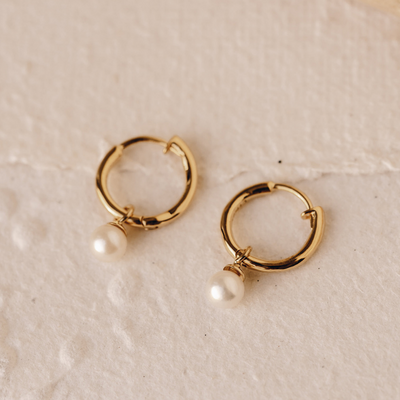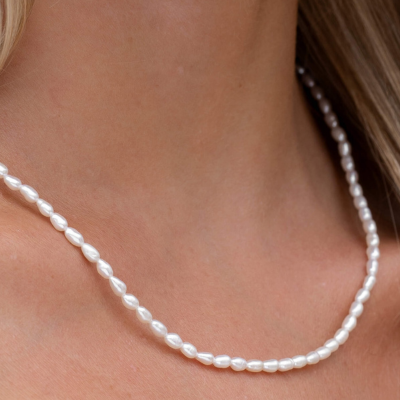Types of Pearls: Everything You Need To Know | Linjer Jewelry
What Is a Pearl?
Pearls are unique and precious gemstones that are formed inside the shells of certain mollusks such as oysters and mussels. They are created when an irritant, such as a piece of sand or a parasite, enters the mollusk. To protect itself, the mollusk secretes a substance called nacre around the irritant, which over time forms into a beautiful and lustrous pearl.
Pearls have a rich history and have been prized by ancient civilizations such as the Egyptians, Greeks, and Romans, for their beauty and rarity. Throughout history, pearls have been associated with wealth, power, and royalty, and were often used to adorn the crowns and jewelry of monarchs! Today, pearls are known for their elegance and timeless beauty and remain a popular choice for jewelry.
Shop Our Favorite Pearl Jewelry
Pearl Huggie Earrings - Kirsten |
Pearl Bracelet - Eli |

See Product |

See Product |
Pearl Necklace - Katja |
Pearl Drop Earrings - Mathilde |

See Product |

See Product |
Natural vs Cultured Pearls
Natural pearls are formed completely by chance inside mollusks in the wild, while cultured pearls are intentionally harvested by humans through a process that involves inserting an irritant into a mollusk to stimulate the formation of a pearl. Cultured pearls are much more affordable and widely available than natural pearls, which are extremely rare and valuable. Additionally, cultured pearls can be produced in a range of sizes, shapes, and colors, making them a versatile option for jewelry designers.
Ultimately, the choice between natural and cultured pearls comes down to personal preference and budget. While natural pearls are highly sought after by collectors and often fetch high prices at auction, cultured pearls are an accessible option for those who love the beauty and elegance of pearls but don't want to break the bank.
How Many Types of Pearls Are There?
It's difficult to give an exact number because there are so many variations of pearls based on factors such as the type of mollusk, the location where the pearl is grown, and the techniques used to cultivate the pearl. That being said, there are five general categories of pearls which are classified based on a variety of factors, including their size, shape, color, and origin. Here’s the lowdown:
- Saltwater pearls: These pearls are grown in oceans and seas around the world, and include types such as Akoya, South Sea, and Tahitian pearls.
- Freshwater pearls: These pearls are grown in freshwater rivers and lakes, and include types such as Biwa and Chinese freshwater pearls.
- Natural pearls: These pearls are formed without human intervention, making them extremely rare and valuable. They are typically small and irregular in shape, and come in a range of colors.
- Cultured pearls: These pearls are grown with human intervention, using a process that involves inserting a small object, such as a bead or piece of tissue, into a mollusk to stimulate the formation of a pearl. Cultured pearls come in a variety of shapes, sizes, and colors.
- Baroque pearls: These pearls have irregular, non-spherical shapes and come in a variety of sizes and colors. They are prized for their unique and organic beauty.
Shop Our Favorite Pearl Jewelry
Hoop Earrings with Pearl - Rebecca |
Baroque Pearl Necklace |

See Product |

See Product |
Keshi Pearl Earrings - Adriana |
Pearl Necklace - Ingrid |

See Product |

See Product |
Types of Pearls
Pearls come in many different types, each with their own unique characteristics and uses. Let’s dive into some of the most popular types:
- Akoya Pearls: Akoya pearls are cultured pearls grown in saltwater oysters found in Japan. These extremely valuable pearls are known for their bright luster, symmetrical round shape, and pale pink color.
- South Sea Pearls: These are the classic white pearls that most people think of when they imagine pearls. They are extremely valuable and are grown in the warm waters of the South Pacific.
- Tahitian Pearls: Also known as black pearls, these pearls are grown in the waters surrounding Tahiti and other Pacific islands. They come in shades of gray, green, blue, and black, and are coveted for their unique and exotic beauty.
- Keshi Pearls: These are non-nucleated, irregularly shaped pearls that consist of solid nacre. Keshi pearls are often very lustrous and have a flat, organic shape that make them a popular choice for more unconventional and unique jewelry designs.
- Coin Pearls: These are flat, disk-shaped pearls that are often used in earrings, bracelets and necklaces. They come in a range of sizes and colors.
- Biwa Pearls: These are freshwater pearls that are grown in Lake Biwa in Japan. They are known for their unique shapes and colors, and are often used in one-of-a-kind jewelry designs.
- Mabe Pearls: These are half-pearls that are grown against the inside of the mollusk's shell rather than inside the body of the mollusk. They are often used in earrings and rings, and can come in a range of colors.
Which Type of Pearl Is Most Expensive?
The value of pearls is influenced by a variety of factors, including their size, shape, color, luster, and surface quality. Here is an overview of the typical value ranges for each of the four main categories of pearls:
- Saltwater pearls: These pearls, which include Akoya, South Sea, and Tahitian pearls, are typically the most expensive due to their rarity and high quality. On average, saltwater pearls can range from $1000 to $20,000 per strand, depending on their size, shape, and color.
- Freshwater pearls: These pearls, which are primarily grown in China, are typically more affordable than saltwater pearls. On average, freshwater pearls can range from $50 to $500 per strand, depending on their quality and luster.
- Natural pearls: These pearls are extremely rare and valuable, as they are formed without human intervention. On average, natural pearls can range from $500 to $10,000 per strand, depending on their size, shape, and quality.
- Cultured pearls: These pearls, which are grown with human intervention, are typically more affordable than natural pearls. On average, cultured pearls can range from $100 to $1000 per strand, depending on their size, shape, and quality.
- Baroque pearls: These pearls have an irregular, non-spherical shape, and can come from any of the four categories of pearls. They are prized for their unique and organic beauty, and can range in price depending on their size, shape, and quality.
The value of pearls can vary widely depending on the type and quality of the pearl. Saltwater pearls are typically the most expensive due to their rarity and high quality, while freshwater pearls and cultured pearls are generally more affordable.
Which Type of Pearl Is Best?
When it comes to pearls, there is no one-size-fits-all answer on which type of pearl is best. What makes a pearl "the best'' depends on a variety of factors, including personal taste, budget, and occasion. Let’s dive into some important factors to consider when choosing a type of pearl:
- Size: Larger pearls are often considered more valuable and luxurious, while smaller pearls can be more delicate and versatile.
- Shape: Round pearls are typically considered the most classic and elegant, while baroque pearls offer a more organic and unconventional beauty.
- Color: Pearls come in a range of colors, from classic white to exotic black and beyond. The best color for a pearl will depend on personal taste and the occasion for which it will be worn.
- Luster: The luster or shine of a pearl is a key factor in its beauty and value. High-quality pearls will have a bright and reflective luster that catches the eye.
Each type of pearl offers its own unique beauty and characteristics, and the choice between them depends on personal taste. Ultimately, the best type of pearl is the one that makes you feel confident and beautiful when you wear it!
If you're looking to add pearls to your jewelry collection, be sure to check out our stunning selection of pearl jewelry. From classic pearl stud earrings to bold pearl necklaces, we offer elegant and timeless pieces that are perfect for any occasion! To learn more about freshwater pearls, be sure to check out our comprehensive guide to everything you need to know about these beautiful pearls.




